HiPACC Data Science Press Room. From: UCD
The Data Science Press Room highlights computational and data science news in all fields *outside of astronomy* in the UC campuses and DOE laboratories comprising the UC-HiPACC consortium. The wording of the short summaries on this page is based on wording in the individual releases or on the summaries on the press release page of the original source. Images are also from the original sources except as stated. Press releases below appear in reverse chronological order (most recent first).
October 22, 2014 — New tool identifies high-priority dams for fish survival
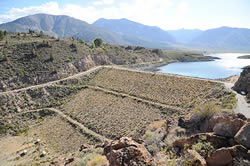
Long Valley Dam on the Owens River is one of 181 California dams UC Davis researchers identified as candidates for increased water flows to protect native fish downstream. Credit: Stephen Volpin
UCD 10/22/2014—Scientists from UC Davis and UC Merced have identified 181 California dams that may need to increase water flows to protect native fish downstream. The screening tool developed by UC Davis’s Center for Watershed Sciences to select “high-priority” dams may be particularly useful during drought years amid competing demands for water. The study started with an analysis of 1,400 Californian dams in several databases, and focused on evaluating 753 large dams, screening them for evidence of altered water flows and damage to fish. Nearly a quarter of them—181—were identified as having flows that may be too low to sustain healthy fish populations. A 2011 study found that 80 percent of California’s native fish are at risk of extinction if present trends continue. “It is unpopular in many circles to talk about providing more water for fish during this drought, but to the extent we care about not driving native fish to extinction, we need a strategy to keep our rivers flowing below dams,” said lead author Ted Grantham, a postdoctoral researcher at UC Davis during the study and currently a research scientist with the U.S. Geological Survey. Findings were published October 15 in the journal
BioScience.
View UCD Data Science Press Release
October 13, 2014 — Interdisciplinary Institute for Social Sciences to tap new potential of researchers
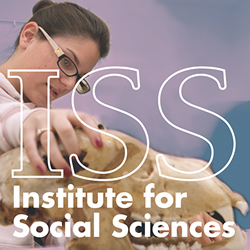
Credit: ISS http://socialscience.ucdavis.edu/about-iss/iss-news/interdisciplinary-institute-for-social-sciences-to-tap-new-potential-of-researchers-at-uc-davis
UCD10/13/2014—A brand new Institute for Social Sciences at UC Davis will promote interdisciplinary research in the social sciences to address challenges within a rapidly changing society, tackling the explosion of new data from sources as varied as Twitter and neuroscience imaging techniques. As an incubator of new ideas, the institute will support work that reaches across culture, class, social norms, politics, mobility, economics, values, technology, language, communication and history, according to its new director Joseph Dumit, a professor of anthropology and science and technology studies at UC Davis. “Social scientists use data to learn empirically about the forces shaping our practices, our interactions, our knowledge and our decisions,” said Dumit. “We need new, interdisciplinary approaches to make the most of these types of data, since today’s concrete problems don’t respect disciplinary lines.” The institute also will expand the Social Science Data Service, which acquires and curates data on society, to offer a wider variety of databases and help researchers access and more creatively analyze data.
View UCD10 Data Science Press Release
October 6, 2014 — Genomic sequencing research funded by Moore Foundation award
UCD 10/6/2014—The Gordon and Betty Moore Foundation has announced the selection of 14 Moore Investigators in Data-Driven Discovery. Among them is C. Titus Brown, visiting associate professor of population health and reproduction at the UC Davis School of Veterinary Medicine. Brown will be awarded $1.5 million over five years to support his research on genomic sequencing at UCD when he arrives in January 2015. Brown uses novel computer science tools to explore large genomic sequencing data sets. While at UCD, he will lead the Laboratory of Data Intensive Biology, which works across developmental biology, molecular biology, bioinformatics, metagenomics, and next-generation sequencing to build better biological understanding. With the grant, Brown is planning to build open software to help biologists discover patterns in large distributed data sets—key to understanding ecology and evolution.
View UCD Data Science Press Release
September 2, 2014 — Genetic diversity of corn is declining in Mexico

The new study contradicts some earlier and more optimistic assessments of corn diversity in Mexico. Credit: Thinkstock photo
UCD 9/2/2014—The genetic diversity of maize, or corn, is declining in Mexico, where the world’s largest food crop originated, report researchers in Mexico and at UC Davis. The findings are particularly sobering at a time when agriculturists around the world are looking to the gene pools of staple foods like corn to dramatically increase food production for a global population expected to top 9 billion by 2050. The new study, which contradicts some earlier and more optimistic assessments of corn diversity in Mexico, appears online in the Proceedings of the National Academy of Sciences. This study—the first to examine changes in maize diversity across Mexico—compares maize diversity estimates from 38 case studies over the past 15 years with data from farmers throughout Mexico. “The question of diversity finally can be answered for maize, thanks to a unique database gathered through this binational project,” said lead author George A. Dyer of El Colegio de México, in Mexico City.
View UCD Data Science Press Release
August 19, 2014 — California has given away rights to far more water than it has

On average, California allocates more than five times the amount of water to users than is available in its rivers and streams. Credit: Josh Viers/UC Merced
UCD 8/19/2014—California has allocated five times more surface water than the state actually has, making it hard for regulators to tell whose supplies should be cut during a drought, reported researchers from two UC campuses. The scientists said California’s water-rights regulator, the State Water Resources Control Board, needs a systematic overhaul of policies and procedures to bridge the gaping disparity, but lacks the legislative authority and funding to do so. Ted Grantham, who conducted the analysis with UC Merced professor Joshua Viers and who explored the state’s water-rights database as a postdoctoral researcher with the UC Davis Center for Watershed Sciences, said the time is ripe for tightening the water-use accounting. Viers and Grantham, now with the U.S. Geological Survey, are working to iron out issues with its database and make the information available to policymakers.
View UCD Data Science Press Release
August 14, 2014 — State of the lake: High (tech) and dry at Tahoe
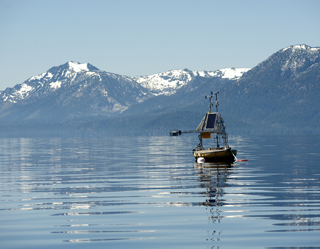
A monitoring station at Lake Tahoe, California. Credit: Gregory Urquiaga/UC Davis
UCD 8/14/2014—46 years after UC Davis first began continuous monitoring of Lake Tahoe, an array of new technologies and computer models are helping scientists better understand what has proven to be a complex ecosystem. The complexities are examined in a report “Tahoe: State of the Lake Report 2014,” released August 14 by the Tahoe Environmental Research Center at UC Davis. The report explains how drought, climate change, and other natural and human factors are driving changes at Lake Tahoe. By combining a half-century of data collection at Lake Tahoe with climate-change forecasts, scientists found that summerlike conditions have been extended at Lake Tahoe. By the end of this century, summer may be two months longer than it was in the 1960s, and maximum temperatures may have risen by 8 degrees Fahrenheit. The report also describes the new Real-time Nearshore Water Quality Network of about 20 monitoring stations—the first six of which were installed in August—to gather minute-by-minute data about changing water quality conditions to explore what is causing degradation to Lake Tahoe’s nearshore environment.
View UCD Data Science Press Release
July 15, 2014 — Drought impact study: California agriculture faces greatest water loss ever seen
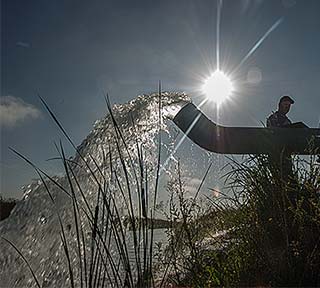
Managing groundwater reserves is key to California’s surviving long-term drought. Here, Senior Engineering Geologist Chris Bonds from the California Department of Water Resources monitors flow rate from a well. Credit: John Chacon/California Department of Water Resources
UCD 7/15/2014—California produces nearly half of U.S.-grown fruits, nuts and vegetables plus nearly a quarter of the nation’s milk and cream; but the nation’s produce basket may come up dry in the future if groundwater reserves continue to be treated like an unlimited savings account. So concluded a new study by the UC Davis Center for Watershed Sciences, released at a press briefing in Washington, D.C. The study updates estimates on the prolonged drought’s effects on Central Valley farm production, presents new data on the state’s coastal and southern farm areas, and forecasts the drought’s economic fallout through 2016. Groundwater reserves are being used to replace surface water losses. If the drought continues for two more years, however, pumping ability will slowly decrease, while costs and losses will slowly increase as the groundwater is depleted. To forecast the economic effects of the drought, the UC Davis researchers used computer models, remote satellite sensing data from NASA, and the latest estimates of State Water Project, federal Central Valley Project and local water deliveries and groundwater pumping capacities.
View UCD Data Science Press Release
May 21, 2014 — Scientists demonstrate improved catalyst control, energy savings could result
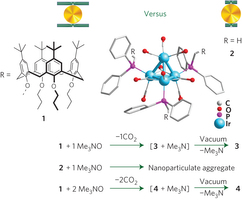
Synthesis and schematic mechanical model of ligand stabilized open-site clusters. Credit: Nature Nanotechnology 9, 459–465 (2014)
UCB/UCD 5/21/14 — Inspired by how enzymes work in nature’s biological processes, researchers have demonstrated a way to improve control of synthetic catalysts. Catalysts accelerate chemical reactions so that they go faster and use less energy. In the research, sponsored by the U.S. Department of Energy, the scientists showed how to switch molecular bonding—the interaction that holds assemblies of atoms together—off and on at will at specific locations within the catalyst. The discovery, researchers said, has potentially profound implications for chemical conversions involving metal catalysts, including pollution abatement. A paper co-authored by Alexander Okrut and Alex Katz of UC Berkeley and Bruce Gates of UC Davis along with University of Alabama computational chemist David Dixon and his graduate student Shengjie Zhang was published in a recent online issue of the journal
Nature Nanotechnology.
View UCB/University of Alabama press release.






